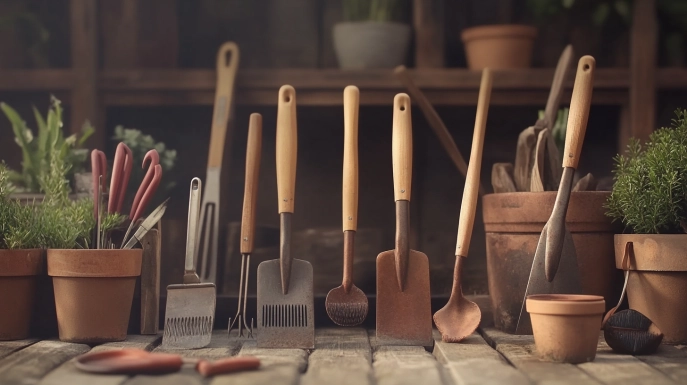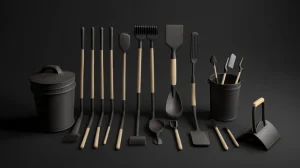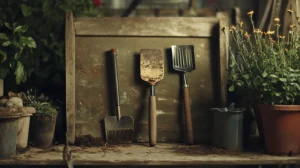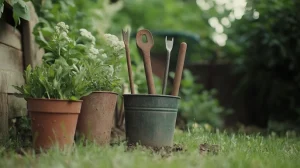
Smith & Hawken Watering Can White Painted Metal, 14″ Long, 7.5″ Tall, 1.1 Liter
- Very good condition.
- Paint is in excellent condition.
- Some very minor scratches on bottom.
Everything You Need to Know Before Purchasing This Garden Essential
The Smith and Hawken watering can is a must-have tool for any gardener. Its classic style and quality construction make it a joy to use. But before purchasing this iconic watering can, there are some key factors you’ll want to consider. This comprehensive buying guide covers all the details – from materials and capacity to special features and accessories. Read on to learn everything you need to know to find the perfect Smith and Hawken watering can for your needs.
Materials Used in Smith and Hawken Watering Cans
One of the main things that sets Smith and Hawken watering cans apart is the superior materials used in their construction. Most Smith and Hawken cans are made from high quality metals like copper, galvanized steel, or aluminum.
Copper offers unmatched durability. It won’t rust, dent, or corrode over time. The satin finish on copper Smith and Hawken cans is stunning. Copper conducts heat well, helping maintain cool water temperatures. But copper is relatively soft, so these cans can dent if dropped from a height.
Galvanized steel has a matte silver finish. It provides excellent rust resistance. Steel is also quite strong, so galvanized steel Smith and Hawken cans resist dents well. The main downside is that steel conducts heat more readily than copper, raising your water’s temperature.
Aluminum Smith and Hawken watering cans are lightweight yet sturdy. They conduct heat minimally. An anodized aluminum finish lends an elegant, protective surface. But aluminum can dent if dropped. It’s also reactive with alkaline soils and fertilizers.
Some Smith and Hawken cans use plastic components in spouts or handles. Plastic helps reduce weight. But all-plastic cans from Smith and Hawken are hard to find since metal lasts much longer.
Capacity of Smith and Hawken Watering Cans
When choosing a Smith and Hawken watering can, the capacity is key. These cans come in sizes ranging from half a gallon to over two gallons.
The smaller 0.5-1 gallon cans work well for indoor plants, smaller outdoor pots, and herb gardens. The most popular outdoor size is 2 gallons, ample for covering medium gardens. Larger 2.5-3 gallon capacities tackle big gardens with less refilling.
Consider how much you’ll realistically water in one session. The extra weight of a jumbo can gets tiring. And leaving water sitting for days breeds bacteria. Pick the smallest can that lets you comfortably water in one go without constant refills.
Rust Resistance
One of the biggest complaints with cheaper watering cans is rust formation. This not only looks unpleasant but causes leaks.
Thankfully, Smith and Hawken cans are designed to be rust-resistant. As mentioned earlier, copper and aluminum cans won’t rust at all. Galvanization gives steel cans exceptional corrosion resistance. Plus, Smith and Hawken applies protective lacquer layers to further prevent rust.
That said, chips in the finish can expose raw steel. Avoid abrasive scouring pads when cleaning galvanized cans. Regular oiling of the inner surface also helps stave off rust. With proper care, your Smith and Hawken can should stay rust-free for years.
How Smith and Hawken Compares to Other Brands
The Smith and Hawken brand has earned devoted fans thanks to the superb quality of their gardening tools. Their watering cans are no exception.
In terms of materials, Smith and Hawken cans deliver where cheap brands fall short. You won’t find flimsy plastic or thin tin. The metals and lacquered finishes far surpass lower-cost cans.
Details like removable spouts, wide mouths, double handles, and flat bottoms prove Smith and Hawken cans are designed by real gardeners. No frustrating flaws exist like awkward shapes, porous seams, or loose joinery.
Smith and Hawken prices do run higher than hardware store cans. But devotees feel the investment is worthwhile for equipment that lasts decade after decade. These cans represent luxury items, make excellent gifts, and frequently get handed down through generations.
Customer Reviews of Smith and Hawken Cans
If you search Smith and Hawken watering cans online, you’ll find glowing customer reviews. Many praise the beauty, durable materials, and thoughtful design details.
Owners love the substantial heft in hand, smooth pouring action, and how these cans evenly distribute water. The iconic copper cans with brass accents earn particular acclaim for their striking aesthetics.
Those who’ve owned their Smith and Hawken can for 5, 10, or even 20+ years attest to the longevity. Many mention these cans still look brand new after years of use.
Critical feedback is hard to find. A few have received cans with small dents, likely from shipping rather than defects. Some report minor leaking if not dried fully after each use. But overall, most agree Smith and Hawken cans are worth every penny.
Detachable Spouts
A major advantage of Smith and Hawken watering cans is removable spouts. By unscrewing the spout, you can easily clean the interior and access every nook and cranny.
Being able to remove spouts also aids storage. The cans take up less space without protruding spouts. Detachable parts also make replacement or upgrades simpler if needed down the road.
When shopping, ensure your selected model specifies a removable spout. A few Smith and Hawken cans have fixed spouts that require more tedious cleaning and provide less flexibility long-term.
Suitability for Indoor Use
Thanks to their smaller capacities and removable spouts, Smith and Hawken watering cans work wonderfully for indoor plants. More compact cans hold just the right amount of water for typical houseplants. The detachable spouts and wide openings allow easy filling from most sinks.
Indoor plants need less frequent watering, so stainless steel or copper Smith and Hawken cans are ideal. Their solid metal construction resists tipping by pets. The elegant antique styling looks far classier than plastic in an indoor setting.
Do keep in mind that metal conducts heat and cold. In very warm rooms, opt for aluminum over copper or steel to prevent overheating the water. Or run taps until water reaches room temperature before filling.
Durability of Smith and Hawken Watering Cans
From the sturdy metals to double-riveted handles, Smith and Hawken constructs their cans to endure. Many owners report still using their original can 20+ years later. With proper care, it’s not unusual for these cans to outlive their owners!
The galvanized steel and copper stand up to dings and abrasions far better than tin or plastic competitors. Though aluminum dents more readily if dropped on hard surfaces.
Pay attention to the fins that attach handles to the can body. Weak points here lead to leaks, but Smith and Hawken cans have securely soldered fins. Just avoid overloading with too much weight or dragging a full can around. With regular gentle handling, expect your can to provide a lifetime of service.
Available Colors
Beyond the basic metal finishes, Smith and Hawken offers select watering cans in various colors.
For a more decorative look, some steel cans come painted in glossy reds, greens, blues, and black. Or opt for a copper can with brass accents for a sophisticated antique appearance.
Enameled steel choices provide a porcelain-like finish in hues like terra cotta, cobalt, plum, and pear. Just keep in mind colored finishes can chip with rough handling.
Those favoring a more modern look may prefer raw galvanized steel or aluminum cans. For timeless appeal, the natural patina of copper never goes out of style.
Using for Fertilizing Plants
The best way to fertilize plants with a Smith and Hawken can is the old-fashioned way – by hand.
Simply don your gloves and sprinkle granulated fertilizer directly over the soil as needed. Then use your Smith and Hawken can filled with plain water to gently wash the fertilizer into the soil. The long spout lets you precision target root zones without drenching the whole plant.
You can pre-mix liquid fertilizers into the can, but this requires fastidious cleaning afterwards. And most plants don’t need fertilized at every watering anyway. Apply it by hand periodically rather than with every use of your can.
Whether fertilizing by hand or with pre-mixed water, go slowly to avoid Washout. Smith and Hawken’s finessed spout gives you maximum control over the water flow.
Ergonomic Design
From balanced proportions to details like dual handles, Smith and Hawken optimizes their cans for comfort and ease of use.
The gently curving body rests easily against your side as you walk. Flat bottoms prevent tipping. Lightweight aluminum or plastic handles reduce arm fatigue, compared to all-metal cans. Dual handles give you a second grip option.
Spouts are designed for precision pouring, not fast deluges. You get a controlled stream to gently soak each plant’s base without flooding the leaves or splashing yourself.
Small thoughtful touches like pouring lips, finger grips, and wide mouths simplify filling, carrying, and tilting the can just right. All in all, Smith and Hawken cans feel like natural extensions of your arm.
Cleaning Your Smith and Hawken Watering Can
With a removable spout and wide mouth, cleaning a Smith and Hawken can is straightforward.
After each use, empty out remaining water to prevent bacteria or algae growth. Give the can a quick rinse. For periodic deep cleaning, detach the spout and scrub the inside with a bottle brush and mild dish soap. Avoid harsh chemicals or abrasives.
To clean the exterior, wipe down with a soft damp cloth. Use baking soda or mild soap to tackle tougher grime. Polish up copper or brass pieces with special metal polishes.
Never submerge the can fully or place in a dishwasher, as this can damage the finish. Taking the time to hand wash gently will keep your can sparkling for decades.
Eco-Friendliness
Smith and Hawken aims for sustainability and eco-conscious practices across their brand. They partner with ethical vendors and artisans worldwide.
Many of their cans utilize recycled metals in construction. They avoid toxic chemicals in lacquers and paints. Packaging utilizes recyclable materials like paper rather than plastics.
Smith and Hawken also engineers their tools for longevity and crafts replacement parts. This reduces environmental waste by avoiding throwaway devices with short lifespans.
On the consumer end, choosing a durable, repairable Smith and Hawken can over a cheap plastic version embodies sustainability. With green care and maintenance, your can minimizes its ecological footprint.
Price Range
Expect to invest more in a Smith and Hawken watering can compared to budget options. But most agree the higher pricing pays off in enduring quality and performance.
Simple steel cans start around $50. Copper and aluminum choices run from $75 to $150. Larger, intricately detailed copper cans exceed $200.
Consider it a long-term investment in your gardening enjoyment. As a high-end artisanal brand, Smith and Hawken doesn’t cut corners. Timeless styling also helps these cans hold their value if reselling later.
For an heirloom piece that enhances your gardening for decades, Smith and Hawken cans justify the higher price tag. Take care of your can and it will take care of your garden in turn.
Warranty
Smith and Hawken Constructs their cans to such high standards that most models do not come with a formal warranty.
However, the company does have a general satisfaction guarantee. If your can arrives damaged, leaks heavily, or has any major defects, contact their customer service within 30 days for replacements or refunds.
Beyond that initial period, Smith and Hawken provides spare parts and maintenance advice to keep your can functioning. Various online tutorials instruct on fixing leaks, dents, clogs, and other issues.
While pricier than big box brands, the superior materials and construction of Smith and Hawken cans make failures unlikely. These cans are built to outlive standard product warranties.
Maintaining Your Smith and Hawken Watering Can
A few simple maintenance practices will keep your Smith and Hawken can in peak form for decades.
- Empty and rinse after each use to prevent interior bacterial or algae growth.
- Fully dry the can before storage to avoid dampness.
- Wipe down exteriors gently to remove dirt and debris that can abrade finishes.
- Hand wash only using mild cleaners – no abrasives or harsh chemicals.
- Detach and clean the spout regularly for full interior access.
- Watch for small leaks and address them early by tightening fixtures.
- Avoid denting by handling gently and not overloading with water.
- Consider sealing porous decorative finishes annually to prevent absorbing excess moisture.
- Oil interior galvanized steel surfaces occasionally to prevent corrosion.
With routine TLC, your investment will pay dividends for the lifetime of your garden and beyond.
Weight and Portability
Thanks to lightweight yet strong metals, most Smith and Hawken cans weigh under 3 pounds when empty. Galvanized steel and aluminum options tend to be lightest.
The slim, rounded body shape allows the can to tuck neatly against your side for easy carrying. Dual handles give you flexibility to shift grips as needed.
Larger 3+ gallon capacities do get heavy when full. But the balanced design still makes it manageable to transport short distances.
For arthritic hands, the 2 gallon size strikes the best balance of ample capacity without burdensome weight when filled. Just take breaks if lugging it long distances.
Overall, Smith and Hawken cans are crafted to make the inevitable hauling as painless as possible. Just watch your footing on slippery or uneven ground when loaded.
Use in Large Gardens
Smith and Hawken offers several can sizes ideal for large gardens, depending on your strength and stamina.
The 3 gallon model provides a nice mid-range capacity for larger yards. While heavy when filled, it cuts down the number of refilling trips required.
Those with expansive planting beds might prefer the 5 or 6 gallon giants. But their substantial weight when full demands good mobility and grip strength.
No matter the size, focus on key zones during each watering session so you don’t have to cover the whole garden in one go. Smith and Hawken’s precise pouring spouts let you target just thirsty areas.
If hauling heavy loads is an issue, consider a long hose attachment for your spout. This lets you leave a filled can in one spot while you move around the garden to water.
Available Accessories
To further extend the versatility of Smith and Hawken cans, the company offers compatible accessories like:
- Rose and shower head attachments to toggle spray patterns
- Hose extensions to reach farther without moving the can
- Stands and wall mounts to conveniently store the can
- Second handles that attach to the main handle for extra leverage
- Casters that convert the flat bottom into rolling wheels
- Engraving services to personalize the can as a gift
- Flower and herb planter attachments that convert the can into a decorative planter
So feel free to customize your can to match your unique gardening needs. These accessories simply clamp or screw onto the can for quick assembly.
Enhanced Usability Through Design
Subtle but savvy design choices make Smith and Hawken cans a dream to use.
- Angled spouts with drainage holes prevent messy dripping.
- Flat stable bases and low centers of gravity prevent tipping.
- Wide openings and smooth interiors ease filling and cleaning.
- Finger grips and pouring lips provide control when tilting.
- Cushioned handles pad hands and absorb shocks.
- Elegant proportions keep the weight balanced.
Everything about a Smith and Hawken can flows intuitively. No awkwardness exists in lifting, aiming, or pouring. The can simply becomes an extension of your body.
After analyzing the key factors, it’s easy to see why the Smith and Hawken watering can earns such devoted fans. Its intersection of form and function is hard to match. This garden essential will quickly become your most-reached for tool.







